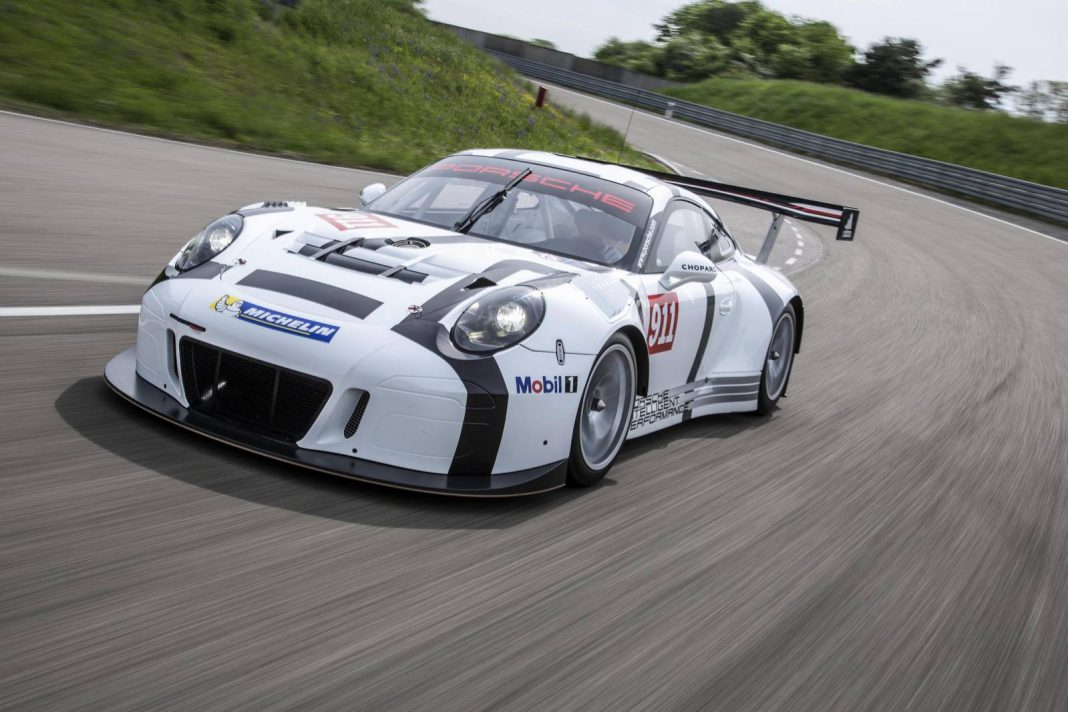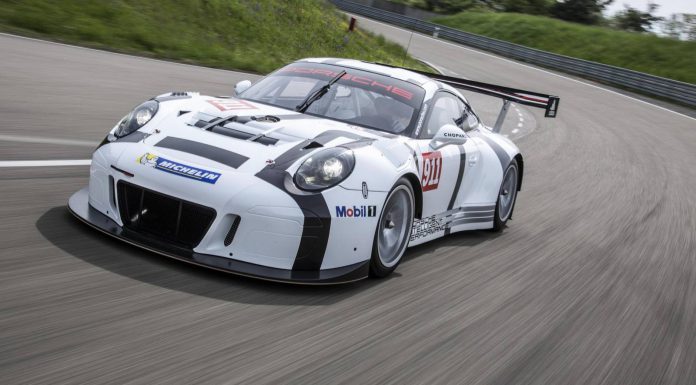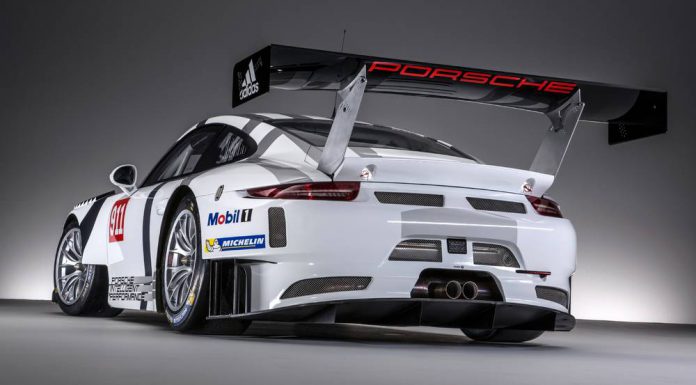Just a couple months after the brand new Porsche 911 GT3 RS was introduced, the racing variant has been revealed in the form of the modified Porsche 911 GT3 R. The car has been created as an adaptation of the road-going car but features a plethora of bespoke components.
Powering the new Porsche 911 GT3 R is a 4.0-litre naturally-aspirated flat-six engine almost identical to the engine powering the road car. While no performance specifications for the race engine have been revealed, it does deliver in excess of the 500 hp offered by the road car. It also utilises direct injection operating at pressures up to 200 bar alongside an advanced variable valve timing system.
Mated to the engine is one of Porsche’s sequential six-speed constant-mesh transmissions sending power through the 310 mm wide rear tyres. As with the road car, paddle shifters are positioned on the steering wheel.
Elsewhere, the new 911 GT3 R includes a thoroughly revised front fascia including a new front splitter. Changes to the rear of the German race car include a new rear wing which measures two metres in width by 40 cm in depth to provide even more downforce than the road car. Interestingly, the side radiators of the road car have been ditched in favour of a centrally-positioned radiator. This change not only improves the vehicle’s centre of gravity but also means the radiator is better protected against collision damage.
From a braking standpoint, the 911 GT3 R includes new ABS anti-lock brakes better suited to long distance racing than the road car. 380 mm ventilated and grooved steel brake discs are featured at the front alongside six-piston aluminium monoblock racing calipers while the rear adopts four-piston calipers and 372 mm discs.
[showhide]
“World debut at the Nürburgring
Based on the new 911 GT3 RS production sports car, Porsche has designed a customer sport race car for GT3 category racing around the world: the 911 GT3 R.
In developing the 500 hp-plus (368 kW) racing ‘nine-eleven’, special attention was paid to its lightweight design, enhanced aerodynamic efficiency, reduced consumption, improved handling, further optimised safety as well as lowering service and spare parts costs.
Adapted from its production sibling, the 911 GT3 R features the distinctive double-bubble roof, and the wheelbase which has been lengthened by 8.3 centimetres compared to the previous generation. This ensures a more balanced weight distribution and more predictable handling particularly in fast corners in comparison to the previous GT3 R.
By applying systematic lightweight solutions for the body, add-on parts, and suspension, Porsche Motorsport engineers significantly optimised the centre of gravity of the GT3 R compared to the predecessor. The lightweight body design of the 911 GT3 RS production sports car featuring intelligent aluminium-steel composite construction has proven to be the ideal basis for the race car. The roof, front cover and fairing, wheel arches, doors, side and tail sections as well as the rear cover are made of particularly light carbon-fibre composite material (CFRP). All windows – and for the first time even the windscreen – comprise of polycarbonate.
Powering the new 911 GT3 R is a cutting-edge 4.0-litre flat-six unit which is largely identical to the high-performance production engine of the road-legal 911 GT3 RS.
Direct petrol injection which operates at pressures up to 200 bar, as well as variable valve timing technology, ensures a particularly efficient use of fuel. Moreover, the normally-aspirated engine offers significantly better driveability and a broader usable rev range.
Power from the rear-mounted engine is transferred to the 310 mm diameter rear wheels via a Porsche sequential six-speed constant-mesh gearbox. As in 911 GT road cars, the driver changes gears via shift paddles conveniently positioned on the steering wheel.
The aerodynamics of the 911 GT3 R also follows the example of the road car. The distinctive wheel arch air vents on the front fairings increase downforce at the front axle. Measuring two metres in width by 40 cm in depth, the rear wing lends aerodynamic balance. From its 911 RSR big brother, the GT3 R has adopted the concept of the centrally-positioned radiator. By eliminating the side radiators, the position of the centre of gravity was improved, the radiator is better protected against collision damage, and the venting of hot air through louvres in the front cover was enhanced.
The brake system of the 911 GT3 R also underwent further modifications and, thanks to increased stiffness and more precise control of the ABS anti-lock brakes, is even better suited to long distance racing. At the front axle, six-piston aluminium monobloc racing brake callipers combined with ventilated and grooved steel brake discs with a diameter of 380 millimetres ensure outstanding braking performances. Fitted at the rear axle are four-piston callipers and discs measuring 372 millimetres.
Another development focus was on the safety features of the GT3 R. The capacity of the further-reinforced FT3 safety fuel cell was increased by 12 litres to now hold 120 litres, with the tank now featuring a fuel cut-off safety valve. The doors and the side windows can be removed, and the escape hatch in the roof is now larger. In the event of an accident, the new racing bucket seat offers pilots even better protection.
The new Porsche 911 GT3 R can be ordered immediately for 429,000 Euro plus country-specific VAT and will be delivered from December 2015.
Technical description Porsche 911 GT3 R (Type 991)
Single-seat customer race car based on the Porsche 911 GT3 RS
Engine
Water-cooled six-cylinder boxer engine (rear mounted)
4,000 cm3; stroke 81.5 mm; bore 102 mm
Output: over 368 kW (500 hp) subject to FIA Balance of Performance (air restrictor)
Four-valve technology
Direct fuel injection
Dry sump lubrication
Transmission
Porsche sequential six-speed constant-mesh gearbox
Mechanical slip differential
Pneumatic gear-shift activation (paddle shift)
Bodyshell
Lightweight body featuring intelligent aluminium-steel composite design
Integrated (welded) roll-cage according to FIA Appendix J
Removable escape hatch in roof
Lightweight exterior design
CFRP doors, rear cover, rear wing, wheel arches, front and rear fairing
Polycarbonate glazing
Removable polycarbonate door windows
FT3 safety fuel cell, approx. 120 litres, with fuel cut off safety valve in accordance with FIA regulations
Air jack system (four jacks)
Suspension
Front axle McPherson strut, adjustable in height, camber and toe
Wheel hubs with centre-lock wheel nuts
Adjustable anti-roll bar blades (left and right)
Power-assisted steering with electro-hydraulic pressure feed
Rear axle
Multi-link independent rear suspension, adjustable in height, camber, toe
Wheel hubs with centre-lock wheel nuts
Adjustable anti-roll bar blades (left and right)
Brake system
Two separate brake circuits for front and rear axles; adjustable by driver via brake balance bar system
Front axle
Six-piston aluminium monobloc racing brake calliper
Ventilated and grooved steel brake disc, diameter 380 mm, aluminium disc bell
Rear axle
Four-piston aluminium monobloc racing brake calliper
Ventilated and grooved steel brake disc, diameter 372 mm, aluminium disc bell
Wheels/tyres
One-piece BBS alloy wheels according to Porsche specification and design
12.0J x 18 offset 17, tyre dimension: 300/650-18 front
13J x 18 offset 37.5, tyre dimension: 310/710-18 rear
Electrics
COSWORTH power module IPS32
Race ABS
Traction control
Weight/dimensions
Total weight: ca. 1,220 kg (subject to Balance of Performance)
Overall length: 4,604 mm
Overall width front axle: 1,975 mm
Overall width rear axle: 2,002 mm
Wheelbase: 2,463 mm
Car price – 429,000 Euros plus country-specific VAT”
[/showhide]

























